Saints of the Day
 |
 |
 |
 |
 |
 |
 |
Humiliation of St. Joseph – December 23-25
- Part IV -
- Part IV -
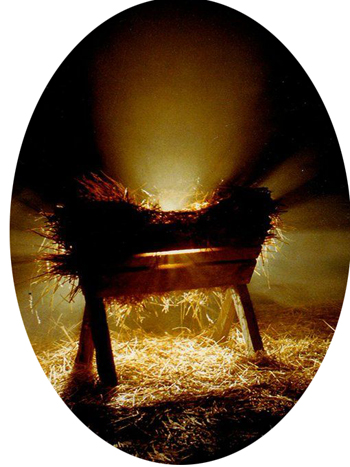
The cave & crib, permeated with a supernatural light
“Then, filled with a holy fear, he entered in his own little cell and prostrated himself on the floor in prayer. The light of the lamps which Joseph had lit was no longer visible. The Blessed Virgin knelt on her rug with her an ample ungirted robe spread out round her, her face turned towards the East. At midnight she was enraptured in an ecstasy of prayer. I saw her lifted from the earth, so that I saw the ground beneath her.”
We can imagine the pleats of her robe falling poetically around her body, and the figure that she made suspended in the air.
“She was at certain distance from the floor: Her hands were crossed on her breast. The radiance around her increased; everything, even things without life, were in a joyful inner motion.”
You see how marvelous the picture is!
“The stones of the roof, of the walls, and of the floor of the cave became alive in the light, moved as it were by the love of inanimate things for God Who had created them.”
The idea that the stones palpitated while the hearts of the Jews did not, makes a beautiful contrast. It is necessary to connect these things to understand the symbols. Catherine Emmerick does not say this because she is not an analyst, she does not analyze anything; she leaves it for us to observe and make the analysis. But the link is obvious and highly moving.
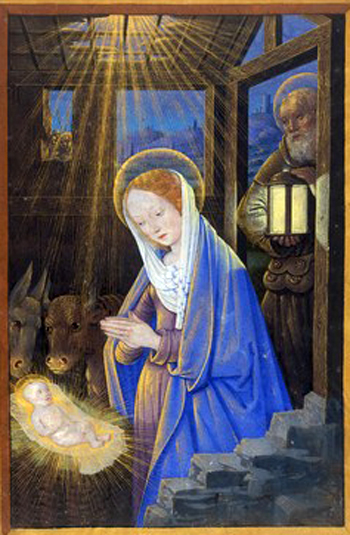
Our Lord, transfigured with light at His birth
“Then I no longer saw the roof of the cave; a pathway of light opened above Mary, rising with ever-increasing glory towards a bright star at the height of Heaven.”
She remained, therefore, as a small point placed at the foot of that colossal star. It was simultaneously the apex of humility and grandness. How small was she close to that great star! But, what grandeur of the person over whom that star stands! Any earthly form of grandeur is nothing in comparison to this!
“In this pathway of light there was a marvelous movement of celestial glories approaching the earth until they appeared more clearly in the form of Choirs of Angels. Meanwhile the Blessed Virgin, suspended in ecstasy, prayed and gazed downwards, adoring her God, whose Mother she had become.”
Thus with an extraordinary tact Anne Catherine Emmerich tells that the Infant was born. A theologian or great author could not describe it better. While she prayed in ecstasy, the Infant was born. She looked above her to the Most Holy Trinity, and afterwards she looked down to see the Second Person Incarnate, her Son! What else would she see or do? She could only gaze down at Christ. Her mission was fulfilled; the Word of God was there, on the ground.
“The Word of God lay on the earth before her on a cushion in the form of a helpless newborn Child.”
Our Lord was born on a cushion on the ground. How? It is a mystery that we do not know. We only know that Our Lady was a virgin before, during and after the parturition. But I do not believe that anyone could describe this birth with more tact or better than she.
“I saw Our Redeemer as a tiny Child, shining with a light that overpowered all the surrounding radiance, laying on the cushion before the knees of the Virgin Mary. It seemed to me as if He were at first quite small and then grew before my eyes. But the movement of the intense radiance was such that I cannot say for certain how I saw it.”
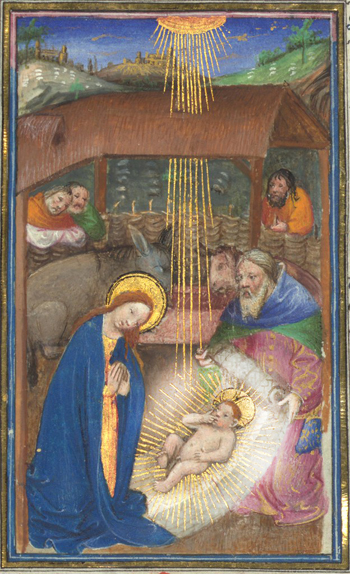
Our Lord, more luminous than the star above
We see at the Crib various lights: the light of St. Joseph's lamps eclipsed by the light of the star; the light of the star eclipsed by the Child Jesus. There were various lights that followed a hierarchy, one eclipsed by the other. In reality one completed the other, as it normally happens in a true hierarchy.
“The Blessed Virgin remained for some time rapt in ecstasy. Then I saw her laying a cloth over the Child, but at first she did not touch Him or take Him up in her arms.”
Look the serenity. Everything is replete with temperance, tranquility, affection and respect: with adoration.
“After some time I saw the Child Jesus move and heard Him cry.”
It was the first weeping that would continue until the Eli, Eli lamma sabacthani? - My God, My God, why hast Thou forsaken Me? He was the Redeemer, the great Sufferer.
“At that moment Mary seemed to come to herself, and she took up the Child wrapped Him in the cloth that covered Him, and held Him in her arms, bringing him close to her breast.”
After she came our of her ecstasy, He cried and she consoled Him: Consolatrix afflictorum – the consoler of the afflicted.
“She sat there enveloping herself and the Child completely in her veil, and I think Mary suckled the Redeemer.
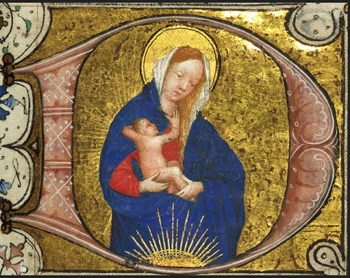
Our Lady takes up the Christ Child to feed Him
“I saw the Angels around her in human forms, inclining themselves and adoring the newborn Infant. It might have been an hour after His Birth when Mary called St. Joseph, who was still prostrate in prayer. When he came near, he prostrated himself again, filled with jubilation, humility and fervor. It was only when Mary asked him to take the Sacred and Most High Gift to his heart, in joy and thankfulness, the holy present of the Most High God, that he stood up and received the Infant Jesus in his arms.”
We can imagine the invitation of Our Lady: “My spouse, take Him into your arms.” She exercises her role as mediatrix. The Child goes to His father because the Mother asked it, she is the Universal Mediatrix of all graces. We can imagine how St. Joseph adored Him.
What would have been the relationship of St. Joseph with Our Lady and the Child Jesus on this occasion? It should have been a true marvelous thing.
“Shedding tears of pure joy Joseph gave thanks to God for the Gift received from Heaven.”
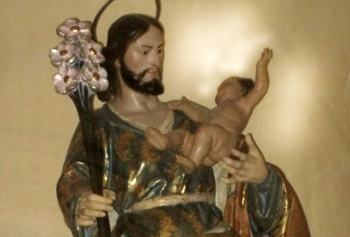
St. Joseph embraces the Christ Child for the first time
“The Blessed Virgin then wrapped the Child Jesus in swaddling-bands. … Then I saw Mary and Joseph sitting side by side on the bare earth with their feet under them. They did not speak, and seemed both to be absorbed in quiet contemplation.”
There was what we can properly call a true consonance between them. They did not need to talk. Each one knew perfectly what the other was feeling.
“On the carpet before Mary lay the newborn Jesus in swaddling clothes, a little Child, beautiful and brilliant as lightning. … Then they laid the Child in the manger, which was filled with rushes and delicate plants and covered with a cloth hanging over the sides. It stood above the stone lying on the ground, to the right of the entrance, where the cave curves and becomes wider towards the south. … After laying the Child in the crib, the two remained on either side of Him, singing canticles of praise to God and shedding tears of joy.”
It would be most beautiful to hear Our Lady singing and St. Joseph responding, or perhaps the voices of them intertwined. Certainly they were singing the Psalms and other prophetic hymns about the Child Who was to come. It should have been of a canticle of a unique harmony.
“Joseph then arranged the Blessed Virgin's resting-place and her seat beside the Crib. Both before and after the Birth of Jesus, I saw the Virgin dressed in white and veiled. I saw her there in the first days after the Nativity, sitting, kneeling, standing, and sleeping on her side, but I never saw her sick or tired.”
Our Lady was conceived without original sin and thus was not subject to our miseries.
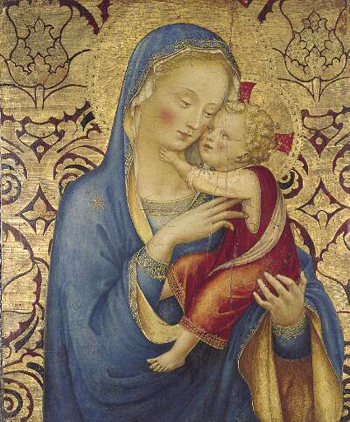
Our Lady, the Universal Mediatrix
When we will receive Communion we should remember the tenderness, the veneration and the adoration that Our Lady gave to Him when He was born and she held Him in her arms, or when St. Joseph received Him from her. We should ask her to give us a good Communion just as she gave to St. Joseph the grace of holding the Child Jesus in his arms. This is the role of mediation of Our Lady. She was mediatrix also to St. Joseph. So let us ask her the grace to have a good Mass filled with the tenderness of Christmas Night.
But since we are in the fight for the Church, we could not forget the dramatic hour through which the Church is passing. So, we should ask Our Lord – through the prayers of Our Lady and St. Joseph – to shorten the suffering of the Church and make the Reign of Mary come soon.

Humiliation of Sr. Joseph - Part II
Humiliation of Sr. Joseph - Part III
 | |
|
|
The texts of both the biographical data and the comments come from personal notes taken by Atila S. Guimarães from 1964 to 1995. Given the fact that the source is a personal notebook, it is possible that at times the biographic notes transcribed here will not rigorously follow the original text read by Prof. Plinio. The commentaries have also been adapted and translated for TIA’s site.


